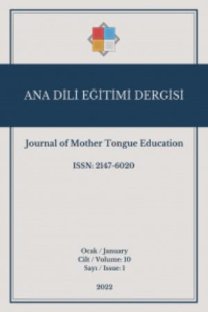Çeviri Çocuk Edebiyatı Eserlerinde Yer Alan Değerler Üzerine Bir Araştırma
Çocukların hemen hemen tüm gelişim evrelerinde sözlü ve yazılı edebiyat ürünlerinden faydalanılmaktadır. Çocuklar, okul öncesi döneminde dinleme becerileriyle, okul döneminde ise hem dinleme hem de okuma becerileriyle çocuk edebiyatı eserlerine ulaşmaktadırlar. Çocuk edebiyatı okuma alışkanlığı kazandırma sürecinde, ana dili öğretiminde ve edebiyat okuru yetiştirmede olduğu kadar, değer aktarımında da oldukça önemli bir yer teşkil etmektedir. Bu sebeple çocuk edebiyatı ürünlerindeki değerlerin farkında olunması ve bu değerlerin niteliğinin incelenmesi gerekmektedir. Değerlerin içerisinde evrensel değerler ve ulusal değerler yer almaktadır. Her ülkenin kendine has ulusal değerleri vardır ve bunları korumak adına milli eğitimlerinin genel amaçlarını ulusal değerlerine göre şekillendirmektedirler. Çocuk edebiyatı ürünlerine dinleme veya okuma becerisiyle ulaşan çocuğun hedeflenen değerleri kazanması daha da kesinleşir, kendisini öğrenerek eğitir ve yaşam boyu sahip olacağı değerlerini belirlemesine katkı sağlar. Bu çalışmada, 6-10 yaş aralığındaki çocuklara yönelik hazırlanmış çeviri romanların değerler eğitimine katkıları tespit edilmiştir. Araştırmanın inceleme nesnelerini, 6-10 yaş aralığındaki çocuklara yönelik 17 ülkeye ait birer öykü oluşturmaktadır. Öyküleri tespit etmek amacıyla “Eğitim Sen İlköğretim Çocuk Edebiyatı Kitap Kataloğu” içerisinde yer alan çeviri çocuk edebiyatı ürünlerinden olan öyküler, ait oldukları ülkelere göre listelenmiştir. Bu listeden yararlanılarak bir form oluşturulup, uzman görüşleri alınmıştır. Verilerin toplanmasında Schwartz Değerler Listesi kullanılmıştır. Derecelendirme yüzde dağılımı şeklinde yapılmıştır. Verilerin analizinde içerik analizi tekniklerinden kategorisel içerik analizi kullanılmıştır. İncelenen eserlerde 869 değer tespit edilmiştir. Bu değerlerin 108 tanesi güç, 55 tanesi başarı, 66 tanesi hazcılık, 55 tanesi uyarılma, 211 tanesi özdenetim, 45 tanesi evrenselcilik, 102 tanesi yardımseverlik, 50 tanesi geleneksellik, 83 tanesi uyum, 94 tanesi de güvenlik değerlerini oluşturmaktadır.
A Research on Values in Translated Children’s Literature Works
Both oral and written literature products are used in nearly all developmental stages of children. Children get access children’s literature works through their listening skills during pre-school period, through their listening and reading skills during schooling period. Children’s literature has an important place in value transfer as well as in the process of encouraging the children to gain the habit of reading, in teaching the mother tongue and raising literature readers. Therefore, it is necessary to be aware of the values presented in children’s literature works and to examine the quality of these values. Values contain both universal and national aspects. As a matter of fact; each country has its own national values and, in order to protect them, shapes its national educational purposes according to those national values. When a child accesses children’s literature works through her/his listening or reading skill; it becomes more and more definite for her/him to acquire target values, thus, to learn and educate her/himself and to determine the values that s/he will have for life. In this study; contributions of the translated novels prepared for 6-10-year-old children to their values education were determined. The research subject of the study is a collection of stories from 17 countries, one from each country, intended for 6-10-yearold children. In order to determine these stories, the translated children’s literature products found in the “Eğitim Sen Elementary School Children’s Literature Book Catalogue” were listed according to their country of origin. This list was used to create a form and obtain field expert opinions. Schwartz Values List was used to collect the data. The rating was made as percentage distribution. In the analysis of the data; categorical content analysis, a content analysis technique, was used. A total of 869 values were determined in the works examined. 108 of these values were related to power, 55 of them to achievement, 66 of them to hedonism, 55 of them to stimulation, 211 of them to self-direction, 45 of them to universalism, 102 of them to benevolence, 50 of them to traditionalism, 83 of them to conformity and 94 of them to security.
___
- Dilmaç, B., & Ulusoy, K. (2014). Değerler eğitimi. Ankara: Pegem Akademi Yayıncılık.
- Kuçuradi, İ. (2013). İnsan ve değerleri. Ankara: Ankamat Matbaacılık.
- Özen, Y. (2001). Yarına kalmak adına sorumluluk eğitimi. Ankara: Nobel Yayın Dağıtım.
- Rokeach, M. (1973). The nature of human values. New York: The Free Pres.
- Tahiroğlu, M. (2012). Değerler eğitiminin ilköğretim 4. sınıf öğrencilerinin trafik kurallarına yönelik tutumlarına etkisi. Mersin Üniversitesi Eğitim Fakültesi Dergisi, 8 (1), 123 -136.
- Turan, S. ve Aktan, D. (2008). Okul hayatında var olan ve olması düşünülen sosyal değerler. Türk Eğitim Bilimleri Dergisi, 6(2), 227-259.
- Yaman, E. (2014). Değerler eğitimi eğitimde yeni ufuklar. Ankara: Akçağ Yayınları.
- Yüksel, S. (2002). Yükseköğretimde eğitim-öğretim faaliyetleri ve örtük program. Uludağ Üniversitesi Eğitim Fakültesi Dergisi, 15(1), 361-370.
